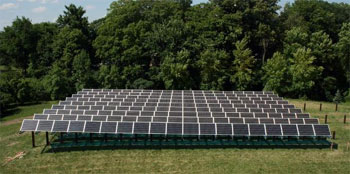Ecolab is signing up to be an anchor tenant – not in a mall, but in community solar gardens in Minnesota.
Headquartered in St. Paul, the Fortune 500 company will run completely on solar in Minnesota by purchasing space at solar gardens being built by SunEdison.
Ecolab is buying more solar than exists in Minnesota right now, which isn’t saying much since there’s only 14 megawatts (MW) in the entire state. But the 16 MW it’s buying will facilitate the coming solar surge there, thanks to Minnesota’s strengthened Renewable Portfolio Standard (RPS).
Despite the introduction of ALEC-inspired bills to repeal the RPS, the state expanded its 25% renewables by 2025 requirement by including a solar carve-out – a minimum 1.5% solar by 2020 and 10% by 2030.
"When people think of solar they tend to think of places like California, Arizona, Hawaii and Florida, not the Midwest. This will open a lot of eyes," Ken Johnson of the Solar Energy Industries Association told Star Tribune.
Community solar array in Minnesota:

Ecolab will be the anchor tenant at SunEdison’s community solar gardens, planned for 15-20 sites in the Twin Cities area. After the 200 MW are built, the gardens will be transferred to SunEdison’s Yieldco, Terraform Power (TERP).
Under Minnesota law, solar gardens must have at least five subscribers and no subscriber can buy more than 40% of its output. Ecolab is buying the maximum 40%, making more community solar installations viable. Like any power purchase agreement, they get the advantage of locked in, lower electricity bills, in this case for 25 years.
Xcel, the state’s largest utility, plans to add an amazing 2.4 gigawatts of solar by 2030 – through community gardens and utility-scale projects, in addition to incentives and grants for rooftop solar.
It will buy energy from projects like Geronimo Energy’s Aurora Solar Project – a series of small, 2-10 MW projects across the state for a total 100 MW.
Wind power is already booming in Minnesota, which ranks #7 among US states. Xcel plans to add 1.8 GW by 2030 on top of the current 3 GW, bringing it to 25% of its electricity.
1000 people are employed by the solar industry and 2000 in wind, where they earn $10,000 a year more than average pay in Minnesota, according to the state’s Commerce Department.
Minnesota is the first state to create a controversial "Value of Solar Tariff" framework. Utilities can either pay people who send solar to the grid at the retail rate (net-metering) or use a formula that includes all the benefits of solar, such as clean air and lower carbon emissions:
